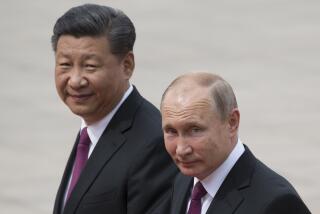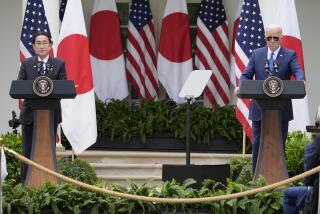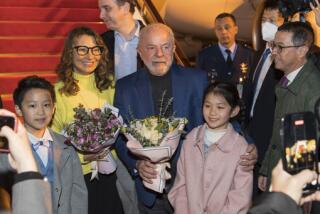DIPLOMACY : Kaifu Heads for China Bearing Olive Branch and an OK of Loans
- Share via
BEIJING — Sino-Japanese relations are approaching a new cordiality with the scheduled arrival Saturday of Japanese Prime Minister Toshiki Kaifu for a four-day official visit.
While American debate continues over whether U.S. trade policy should be used to punish China for human rights violations, Kaifu will become the first head of government from the industrialized democracies to visit Beijing since the 1989 crackdown on pro-democracy protests in Tian An Men Square.
While in Beijing, Kaifu is expected to formally approve the release of about $950 million in previously promised development loans for irrigation projects, hydroelectric plants and other projects aimed at raising Chinese living standards. The low-interest loans are for the second year of a $6-billion 1990-1995 aid package.
Meetings are scheduled between Kaifu and Chinese Premier Li Peng, General Secretary Jiang Zemin and President Yang Shangkun. It is considered unlikely that he will meet senior leader Deng Xiaoping, who is still the most powerful man in China but has formally retired.
Kaifu’s visit not only marks the full restoration of normal Sino-Japanese relations but also the virtual end of the international isolation imposed on Beijing in the wake of the 1989 massacre. British Prime Minister John Major will follow in Kaifu’s footsteps next month.
The state-run Chinese media have welcomed Kaifu’s impending visit with something approaching glee. Sun Pinghua, president of the China-Japan Friendship Assn., was quoted Thursday by the official New China News Agency as predicting that Kaifu’s visit “could serve as an opportunity to draw up a more ideal blueprint for Sino-Japanese relations in the forthcoming century.
“The present Japan-China ties are like the spring sun rising high in the heavens,” Sun told the official Chinese news agency. “There exist no major obstacles in the Sino-Japanese relationship, and thus it should continue to develop on the present favorable basis.”
State Council spokesman Yuan Mu, in remarks quoted by the New China News Agency, said the Chinese government “warmly welcomes” Kaifu’s visit. Yuan also reiterated that China would welcome a future visit, perhaps as early as next year, by Japanese Emperor Akihito.
For more than a year, Japan has played the leading role in lobbying its democratic Western partners to move forward with closer relations with China, rather than continuing to punish it for the brutal 1989 crackdown.
This spring, Tokyo announced that future foreign aid grants would take into account the receiving country’s record on such issues as military spending, arms sales, political and economic freedoms and environmental policies.
Kaifu is not expected to lecture or confront Chinese leaders on these issues, but rather to seek to quietly encourage shifts toward more forward-looking policies.
Japanese officials have indicated that they believe this soft approach to relations with China, including only muted criticism of human rights abuses, is paying dividends in terms of Chinese policy shifts toward positions more acceptable to the West on issues including Cambodia, North Korea, arms sales and human rights within China.
Kaifu will travel on from Beijing to the Mongolian capital of Ulan Bator for a two-day visit, becoming the first Japanese prime minister ever to visit that landlocked nation. He is expected to show Japanese support for Mongolia’s movement away from communism and central planning toward a market economy.
Kaifu is scheduled to announce grants of $11 million to improve Mongolia’s communications structure.
The grants are also meant to lay the groundwork for an international conference on aid to Mongolia that Japan will host in Tokyo in September.
Japan’s Aid to China
Japan’s loans and grants to China have escalated over the last several years. For the 1990-95 period, Tokyo has promised a total of $6 billion.
1984: 389.35 1985: 387.89 1986: 496.95 1987: 553.1 1988: 673.7 1989: 832.0
Source: Japanese Embassy
More to Read
Sign up for Essential California
The most important California stories and recommendations in your inbox every morning.
You may occasionally receive promotional content from the Los Angeles Times.












